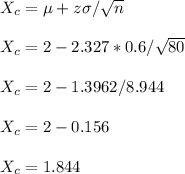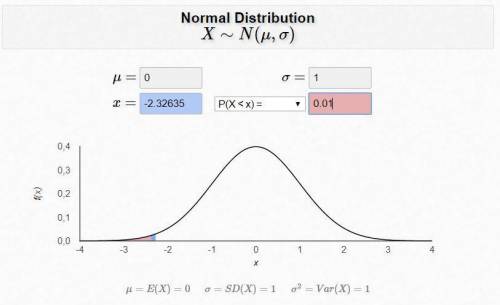
Mathematics, 14.04.2020 21:14 casie65
A process for a certain type of ore is designed to reduce the concentration of impurities to less than 2%. It is known that the standard deviation of impurities for processed ore is 0.6%. Let µ represent the mean impurity level, in percent, for ore specimens treated by this process. The impurity of 80 ore specimens is measured, and a test of the hypothesis H0: µ > 2 versus H1: µ < 2 will be performed.
a. If the test is made at the 1% level, what is the rejection region?

Answers: 2


Other questions on the subject: Mathematics

Mathematics, 21.06.2019 17:00, BackUpAccount
Jose bought 20 shares of netflix at the close price of $117.98. in a few years, jose sells all of his shares at $128.34. how much money did jose make? a.) $192.50 b.) $207.20 c.) $212.50 d.) $224.60
Answers: 1

Mathematics, 21.06.2019 19:00, Patricia2121
Me with geometry ! in this figure, bc is a perpendicular bisects of kj. dm is the angle bisects of bdj. what is the measure of bdm? •60° •90° •30° •45°
Answers: 2

Mathematics, 22.06.2019 01:00, lolhgb9526
Sanderson is having trouble with his assignment. his shown work is as follows: − 3 7 7 3 = − 3 7 × 7 3 = − 21 21 = −1 however, his answer does not match the answer that his teacher gives him. complete the description of sanderson's mistake. find the correct answer.
Answers: 3

Mathematics, 22.06.2019 03:20, arangoaiden71
Aconcession manager at yankee stadium wants to know how temperature affects beer sales. she took a sample of 10 games and recorded the number of beers sold and the temperature in the middle of the game. temperature 80 68 78 79 87 74 86 92 77 84 number of beers 20533 1439 13829 21286 30985 17187 30240 87596 9610 28742 a. draw a scatter plot of the data. b. the manager estimates the regression equation to be: numberofbeers = −100, 678 + 1, 513 ∗ temperature draw this on your scatter plot. c. for one of the estimated points, indicate the residual with ei . d. for that same point, indicate what part of the variation is explained by the model with ˆyi − y¯.
Answers: 2
You know the right answer?
A process for a certain type of ore is designed to reduce the concentration of impurities to less th...
Questions in other subjects:

English, 30.03.2021 04:20

History, 30.03.2021 04:20

Mathematics, 30.03.2021 04:20



History, 30.03.2021 04:20




English, 30.03.2021 04:20





